For the 2025 school year, there are 2 public middle schools serving 356 students in Caro Community Schools School District. This district's average middle testing ranking is 4/10, which is in the bottom 50% of public middle schools in Michigan.
Public Middle Schools in Caro Community Schools School District have an average math proficiency score of 24% (versus the Michigan public middle school average of 31%), and reading proficiency score of 33% (versus the 44% statewide average).
Minority enrollment is 10% of the student body (majority Hispanic), which is less than the Michigan public middle school average of 42% (majority Black).
Overview
This School District
This State (MI)
# Schools
5 Schools
1,349 Schools
# Students
1,388 Students
537,315 Students
# Teachers
85 Teachers
31,652 Teachers
Student : Teacher Ratio
16:1
16:1
District Rank
Caro Community Schools School District, which is ranked within the bottom 50% of all 851 school districts in Michigan (based off of combined math and reading proficiency testing data) for the 2021-2022 school year.
The school district's graduation rate of 75-79% has stayed relatively flat over five school years.
Overall District Rank
#481 out of 866 school districts
(Bottom 50%)
(Bottom 50%)
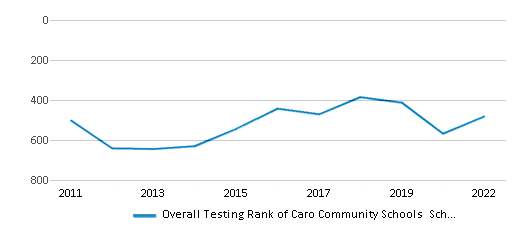
Math Test Scores (% Proficient)
27%
34%
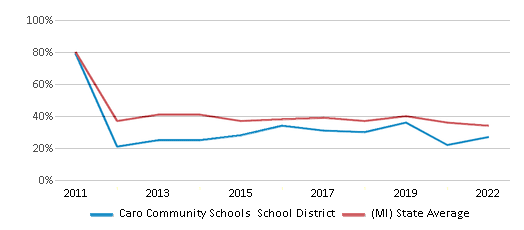
Reading/Language Arts Test Scores (% Proficient)
37%
45%
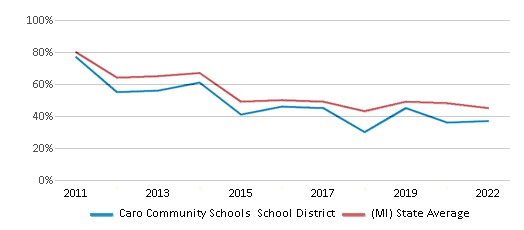
Science Test Scores (% Proficient)
38%
38%
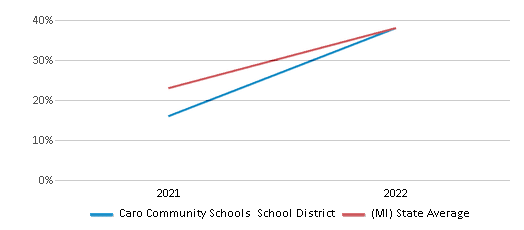
Graduation Rate
75-79%
81%
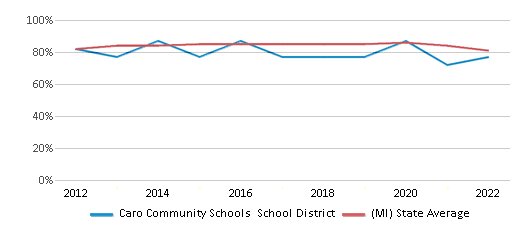
Students by Ethnicity:
Diversity Score
0.20
0.60
# American Indian Students
6 Students
5,345 Students
% American Indian Students
n/a
1%
# Asian Students
9 Students
19,936 Students
% Asian Students
1%
4%
# Hispanic Students
84 Students
47,905 Students
% Hispanic Students
6%
9%
# Black Students
14 Students
122,970 Students
% Black Students
1%
23%
# White Students
1,240 Students
312,168 Students
% White Students
89%
58%
# Hawaiian Students
1 Student
471 Students
% Hawaiian Students
n/a
n/a
# Two or more races Students
34 Students
27,717 Students
% of Two or more races Students
3%
5%
Students by Grade:
# Students in PK Grade:
-
-
# Students in K Grade:
118
17,744
# Students in 1st Grade:
110
17,631
# Students in 2nd Grade:
92
18,045
# Students in 3rd Grade:
108
17,646
# Students in 4th Grade:
94
18,813
# Students in 5th Grade:
91
26,385
# Students in 6th Grade:
100
87,228
# Students in 7th Grade:
108
103,285
# Students in 8th Grade:
99
102,692
# Students in 9th Grade:
125
33,855
# Students in 10th Grade:
101
31,157
# Students in 11th Grade:
112
30,339
# Students in 12th Grade:
124
30,343
# Ungraded Students:
6
2,152
District Revenue and Spending
The revenue/student of $15,412 in this school district is less than the state median of $18,510. The school district revenue/student has grown by 6% over four school years.
The school district's spending/student of $13,392 is less than the state median of $17,693. The school district spending/student has grown by 6% over four school years.
Total Revenue
$21 MM
$25,476 MM
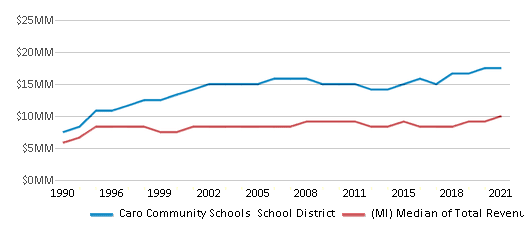
Spending
$19 MM
$24,351 MM

Revenue / Student
$15,412
$18,510
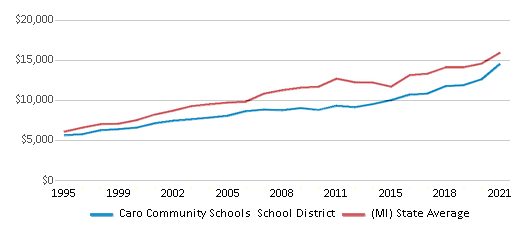
Spending / Student
$13,392
$17,693
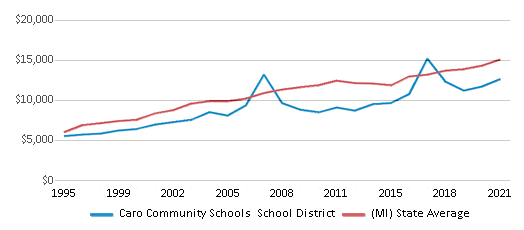
Best Caro Community Schools School District Public Middle Schools (2025)
School
(Math and Reading Proficiency)
(Math and Reading Proficiency)
Location
Grades
Students
Rank: #11.
Caro Alternative High School
Alternative School
(Math: <50% | Reading: <50%)
Rank:
Rank:
8/
Top 30%10
217 N State St
Caro, MI 48723
(989) 673-6845
Caro, MI 48723
(989) 673-6845
Grades: 7-12
| 49 students
Rank: #22.
Caro Middle School
(Math: 23% | Reading: 33%)
Rank:
Rank:
4/
Bottom 50%10
299 N Hooper St
Caro, MI 48723
(989) 673-3167
Caro, MI 48723
(989) 673-3167
Grades: 6-8
| 307 students
Recent Articles

Year-Round Or Traditional Schedule?
Which is more appropriate for your child? A year-round attendance schedule or traditional schedule? We look at the pros and cons.

Why You Should Encourage Your Child to Join a Sports Team
Participating in team sports has a great many benefits for children, there is no doubt. In this article you will learn what those benefits are.

White Students are Now the Minority in U.S. Public Schools
Increasing birth rates among immigrant families from Asia and Central and South America, combined with lower birth rates among white families, means that for the first time in history, public school students in the United States are majority-minority. This shift in demographics poses difficulties for schools as they work to accommodate children of varying language abilities and socio-economic backgrounds.





